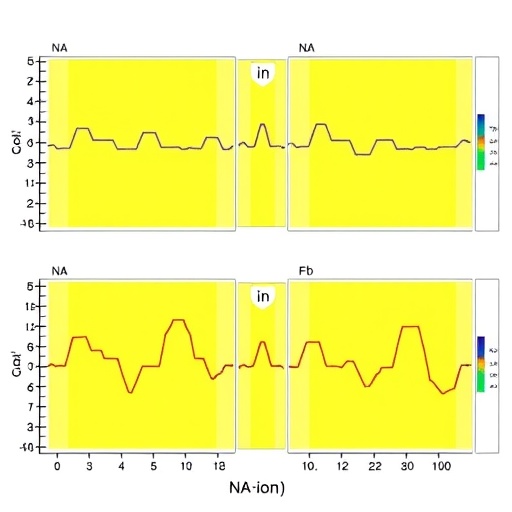Researchers have long been on the hunt for innovative materials that can enhance the performance of sodium-ion batteries, a promising alternative to traditional lithium-ion batteries. A recent study undertaken by an accomplished team of scientists, including Qiu, Lu, and Sun, has made significant strides in this area. Their investigation into the impact of strontium (Sr) doping on the electrochemical performance of O3-NaNi1/3Fe1/3Mn1/3O2 cathode material reveals exciting findings that could spur advancements in energy storage technologies. This research not only provides insights into the fundamental properties of the material but also presents a pathway for optimizing performance in practical applications.
The exploration of sodium-ion batteries is gaining traction as the need for energy storage solutions grows alongside the increasing demand for renewable energy. Sodium, being abundant and cost-effective, stands out as a compelling alternative to lithium. However, researchers have faced challenges in enhancing the energy density and overall efficiency of sodium-ion batteries. The work of Qiu and colleagues contributes to addressing these challenges by investigating the electrochemical performance improvements that arise from the strategic doping of Sr into the O3-NaNi1/3Fe1/3Mn1/3O2 matrix. The findings shed light on the role of dopants in modifying the electronic and structural properties of cathode materials.
By employing advanced characterization techniques, the research team was able to discern the key changes in morphology and electrochemical behavior resulting from Sr doping. These modifications not only enhance the structural stability of the material but also improve ion conductivity and charge transfer during battery operation. The synergistic effects of the doped elements create an optimized environment for sodium-ion migration, ultimately leading to higher capacity and longer cycle life for the batteries. Such breakthroughs are vital for developing sustainable energy storage solutions that can effectively support electric vehicles and renewable energy systems.
.adsslot_IURrfKWm1k{ width:728px !important; height:90px !important; }
@media (max-width:1199px) { .adsslot_IURrfKWm1k{ width:468px !important; height:60px !important; } }
@media (max-width:767px) { .adsslot_IURrfKWm1k{ width:320px !important; height:50px !important; } }
ADVERTISEMENT
The study goes further by analyzing the electrochemical performance metrics of the doped cathodes. Tests reveal that Sr-doped O3-NaNi1/3Fe1/3Mn1/3O2 exhibits significantly improved discharge capacity compared to its undoped counterparts. This improvement suggests that the doping process effectively enhances the material’s ability to store and release energy, addressing one of the key limitations in existing sodium-ion technologies. The ability to achieve higher energy densities means that sodium-ion batteries could potentially compete with lithium-ion batteries in various applications, thereby diversifying the options available for energy storage systems.
Furthermore, the research underscores the importance of structural integrity in cathode materials. The stability of the crystal structure is crucial for maintaining performance over repeated charge-discharge cycles. In their findings, Qiu and colleagues report that the Sr doping helps preserve the structural integrity of O3-NaNi1/3Fe1/3Mn1/3O2 even under strenuous cycling conditions. This stability translates not only into improved capacity retention but also into enhanced safety and reliability, which are critical factors for commercial applications in consumer electronics and electric vehicles.
The implications of this research extend beyond mere theoretical contributions to the field. By demonstrating the practicality of Sr-doped cathodes, the authors pave the way for future developments in sodium-ion technology. As the world transitions to greener energy practices, having reliable battery technologies with reduced reliance on scarce materials aligns well with sustainability goals. The study’s findings hold promise for manufacturers and researchers alike, offering insights that could lead to the creation of next-generation batteries with improved efficiency and environmental compatibility.
In addition to enhanced electrochemical performance, the research discusses the cost-effectiveness of utilizing sodium as a base material. With the abundance of sodium resources, coupled with the successful incorporation of effective doping strategies, the potential for scaling production of high-performance batteries becomes a feasible reality. This strategic approach fosters an environment for further innovation, driving discussions around the feasibility of deploying sodium-ion batteries in widespread applications, including grid storage and industrial scale applications.
In summary, the groundbreaking work by Qiu, Lu, and Sun demonstrates that Sr doping significantly improves the electrochemical performance of O3-NaNi1/3Fe1/3Mn1/3O2 cathode material. Their findings address critical challenges faced by the sodium-ion battery community while unveiling new opportunities for the exploration of doped materials in battery technology. This research not only provides a comprehensive understanding of the material’s properties but also inspires further investigations into other dopants and their potential capabilities.
As further insights emerge from studies like this one, the future looks bright for sodium-ion batteries. With continued research and development, the dream of creating efficient, cost-effective energy storage systems can soon transform into reality. The advancements presented pave the way for more sustainable energy solutions, crucial for addressing the pressing challenges of energy storage in the 21st century. Indubitably, this pioneering work adds to the growing body of knowledge that is vital for accelerating the commercialization of sodium-ion technology, ultimately contributing to a cleaner and greener future for all.
Ultimately, as the world increasingly depends on advanced energy storage solutions, the innovations sparked by such research will play a vital role. The exploration of strontium doping is just the beginning of what could be a series of breakthroughs in sodium-ion batteries, potentially leading to the next generation of energy storage technologies. With these developments, we can look forward to more reliable, efficient, and sustainable energy solutions that will meet the needs of future generations.
Subject of Research: Enhancement of Sodium-Ion Battery Performance through Sr Doping
Article Title: Sr Doping Improving Electrochemical Performance of O3-NaNi1/3Fe1/3Mn1/3O2 Cathode Material in Sodium-Ion Batteries
Article References:
Qiu, Z., Lu, Y., Sun, J. et al. Sr doping improving electrochemical performance of O3-NaNi1/3Fe1/3Mn1/3O2 cathode material in sodium-ion batteries. Ionics (2025). https://doi.org/10.1007/s11581-025-06575-9
Image Credits: AI Generated
DOI: https://doi.org/10.1007/s11581-025-06575-9
Keywords: Sodium-ion batteries, Sr doping, electrochemical performance, O3-NaNi1/3Fe1/3Mn1/3O2, energy storage solutions, sustainability, battery technology, advanced materials.
Tags: challenges in energy density improvementelectrochemical performance enhancementelectronic properties of cathodesenergy storage technology advancementslithium-ion battery alternativesO3-NaNi1/3Fe1/3Mn1/3O2 materialsoptimizing battery performanceRenewable energy solutionssodium ion batteriesstrategic doping in battery materialsstrontium doping in cathodesstructural modifications in sodium-ion batteries





